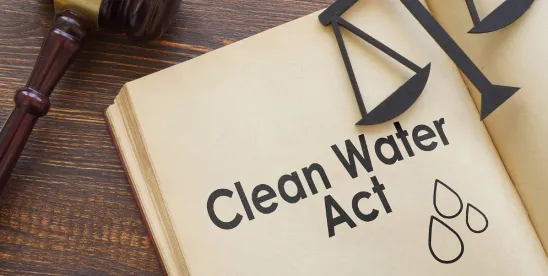Each year, many California businesses receive letters from private entities, typically environmental nongovernmental organizations (Citizen Groups), alleging that those businesses’ facilities are in violation of applicable stormwater permits. The letters, commonly referred to as Notices of Violations and Intent to File Suit (Notice Letters), are authorized by the Clean Water Act’s citizen suit provision and often threaten litigation with steep civil monetary penalties up to $68,445 per violation, per day.
Resolving Notice Letters is costly and typically requires a business to retain legal counsel and an environmental consultant. Although most Notice Letters are resolved through settlement and do not result in extensive litigation, settlement payments can be substantial. Settlement agreements also often include terms for injunctive relief that obligate the owner/operator of a facility (or discharger) to make certain stormwater-related improvements, further adding to the costs associated with resolving Notice Letter allegations.
Receiving a Notice Letter that threatens legal action is a stressful experience for any business owner. This article provides an overview of California’s Clean Water Act permitting programs for industrial dischargers, including the Industrial General Permit (IGP), and offers practical tips on how dischargers subject to those permits can reduce the risk of receiving a Notice Letter. A copy of the IGP and its attachments is available here.
BACKGROUND
The Clean Water Act (CWA) prohibits discharges from point sources to waters of the United States unless the discharges are in compliance with a National Pollutant Discharge Elimination System (NPDES) permit. Section 402(p) of the CWA specifically regulates discharges of stormwater associated with industrial activity. Like most states, California has been delegated permitting authority under the CWA and, through the State Water Resources Control Board, develops its own NPDES permits for stormwater discharges associated with industrial activities, which are then implemented by one of California’s nine Regional Water Quality Control Boards.
California has a “general” industrial discharge permit — the IGP — which allows many prospective permittees to obtain NPDES coverage in a fairly consistent and uniform manner in exchange for agreeing to a similarly consistent and uniform set of permit conditions and requirements. The IGP applies to a wide variety of industries such as heavy manufacturing (paper mills, petroleum refineries, and chemical plants); mineral mining and oil and gas exploration and processing; and metal fabricators, scrapyards, and automobile junkyards. A comprehensive discussion of covered facilities is found in Attachment A to the IGP, available here.
For permittees that do not qualify or otherwise choose not to seek coverage under the IGP, California also issues site-specific industrial discharge permits. These site-specific permits are often utilized by large manufacturing facilities and/or dischargers with unusual or complex operations and ideally provide permit conditions tailored to the facility and operations at issue.
Under the IGP and virtually all site-specific industrial discharge permits, dischargers are required to take certain actions to protect waters of the United States from facility discharges, including the following:
- Develop a Stormwater Pollution Prevention Plan (SWPPP) (a site-specific document that identifies potential sources of pollutants in stormwater and Best Management Practices (BMPs) to reduce any discharges associated with those pollutants).
- Adequately train on-site personnel (and maintain training log documentation) to implement the BMPs identified in the SWPPP.
- Collect and analyze stormwater samples (up to four times per year under the IGP) to confirm the effectiveness of the SWPPP and BMPs.
Finally, the IGP requires permittees to upload documentation to a publicly accessible database maintained by the SWRCB and known as the Stormwater Multiple Application and Report Tracking System (SMARTS), while site-specific permittees are typically required to upload documentation to a similar database known as the California Integrated Water Quality System (CIWQS).
BEST PRACTICES FOR AVOIDING A NOTICE LETTER
The best approach for dischargers to avoid a Notice Letter is to be proactive with compliance at their facilities, particularly with regard to submitting timely and correct documentation to SMARTS and/or CIWQS. Citizen groups seldom identify a facility with potential violations by visiting or personally observing that facility. Instead, citizen groups will often search SMARTS and CIWQS for signs that facilities are not in compliance with permit conditions.
Below are some of the most common reasons facilities are targeted by citizen groups:
- Outdated SWPPPs: Numerous facilities operate under a SWPPP that is several years old and does not contain permit-required information or accurately reflect current facility operations.
- Lack of Sampling: A failure to sample the requisite number of times, usually twice between July 1 and December 31 and twice between January 1 and June 30, may constitute a violation of the IGP. Of course, if a storm event does not have sufficient precipitation to produce a discharge, or occurs outside the facility’s operating hours, then no sampling is required. However, a prolonged lack of sampling in an area with documented storm events will draw the attention of citizen groups.
- Overdue Ad Hoc Monitoring Reports and Annual Reports: Under the IGP, stormwater sampling results are required to be submitted to SMARTS within 30 days of receiving the lab report while the Annual Report must be submitted no later than July 15 following each reporting year. Facilities that submit required reports after these deadlines are attractive targets for citizen groups.
As the above points illustrate, many facilities become targets for citizen suits not based on actual discharge violations or egregious harm to the environment, but from the failure to properly and timely follow procedural requirements set forth in the applicable permit. Ensuring compliance with these procedural requirements is one of the most simple and cost-effective ways dischargers can reduce the risk of receiving a Notice Letter and becoming a target for citizen suit enforcement.
CONCLUSION
Clean Water Act permit requirements can be onerous and industrial dischargers, in particular, face significant scrutiny from citizen groups. Taking proactive steps to ensure compliance with the procedural requirements of these permits can be an efficient and highly effective method of dissuading citizen groups from issuing Notice Letters and bringing citizen suits. If a discharger is either unaware of its compliance status or is having difficulty ensuring compliance, it should consider retaining an outside environmental consultant to assist with this work.



 />i
/>i
